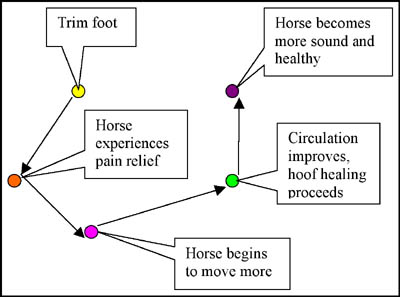
Order and Chaos in the Horse's Hoof
by Cynthia Niemela ©2007, as published in Issue 23 of The Horse's Hoof Magazine
by Cynthia Niemela
I started trimming my own horses in 2001, after reading “A
Lifetime of Soundness” and “Shoeing: A Necessary Evil?” I got
some help with the tools from my farrier. Four months later, Nancy Filbert,
Strasser Graduate of 2001, came out and did a presentation for me and 6 other
horse owners in my area. We all continued to trim together, and each of us seemed
to have gotten different points of emphasis from Nancy, so we also learned from
each other. In the fall of 2002, I signed up for Dr. Strasser’s Certification
Course, and then graduated in 2003. I have been trimming ever since, sometimes
as many as 100 horses in a month.
Lately, I have continued my studies with the “Mustang Model,”
as taught by Jaime Jackson, and I am working towards certification with the
AANHCP (American Association of Natural Hoof Care Practitioners). In March,
2006, I attended the annual AANHCP Conference. There, I heard a presentation
by Dr. Leslie Emory, PhD, on “Thinking and Engaging the Naturally Paradoxical
Dynamics of Sequential, Convergent, and Interactive Causation” or “The
Implications of Order and Chaos in the Biodynamic Phenomena of the Equine Hoof.”
Finally, someone has given me a visual understanding of the frustrations involved
with trimming horse feet! So, please let me explain.
Early on, I began to visualize the various aspects of trimming
to be like juggling. First, you learn a basic model for trimming the horse.
Then, you learn about pathology, and experience helps you to begin to identify
problems that are going to appear, as you progress with the trim. Next, you
take a look at the horse’s environment. Is the footing hard or soft? Is
it rocky or muddy? Wet or dry? How much exercise is the horse getting? Is the
owner feeding the horse appropriately, or are they adding little extras that
might be impacting the hooves?
Then I realized that our weather up here in Northern Minnesota
had a huge impact on the hooves, and I had to plan for and accommodate snow,
ice, freeze/thaw cycles, mud in the spring and fall, and hard-packed clay in
the summer. Since a hoof takes a couple of months to begin to respond to changes
in footing, I then had to add the time for hoof response to my juggling act.
Dr. Emory added some new perspective to the struggle. He pointed out that we have a society that thinks both linearly and mechanistically. In other words, we expect that we will get a certain response to an action every time we do it, and that there will be further consequences that will also follow in a linear fashion. Drawing 1 represents that kind of thinking.

Drawing 1
But this is only one of many possible ways that one action, like trimming the foot, can affect the organism. Drawing 2 illustrates a linear feedback loop. In this instance, the trimming of the foot will cause all of the impacts that are expected, and then also impact the way the foot needs to be trimmed the next time.
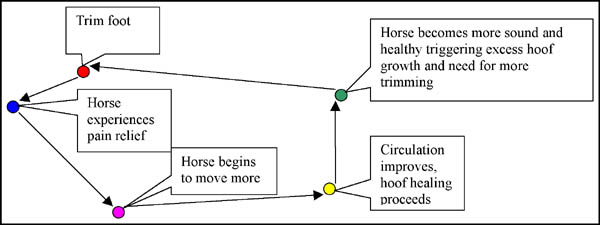
Drawing 2
So these first two drawings illustrate possible linear, sequential
interpretation of events caused by a trim.
Drawing 3 is another viewpoint. In this interpretation, the trim, or the point at the top, causes four different reactions. None of the reactions are related. It is a divergent, radial causation diagram. In this diagram, the trim would cause four separate reactions that are independent of each other.
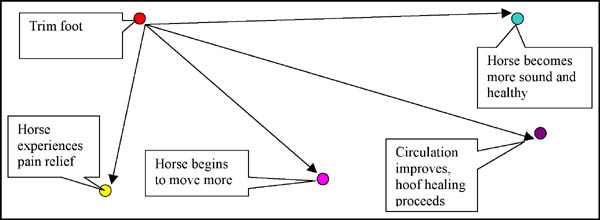
Drawing 3
Or maybe, the trimming of the horse is like the Drawing 4—a convergent, radial causation diagram. Maybe the trim is one of a number of other actions that result in the desired (or undesired) response of the hoof.
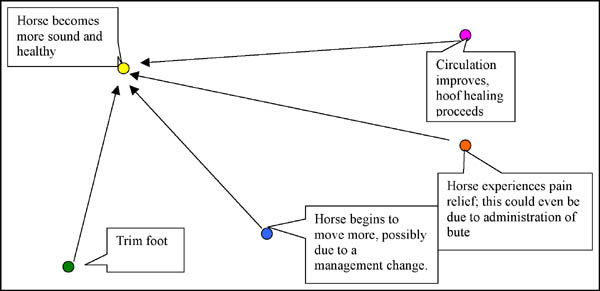
Drawing 4
However, the reality is that the hoof is a very complex, interactive system and the trim is a part of a diagram that probably looks more like Drawing 5.
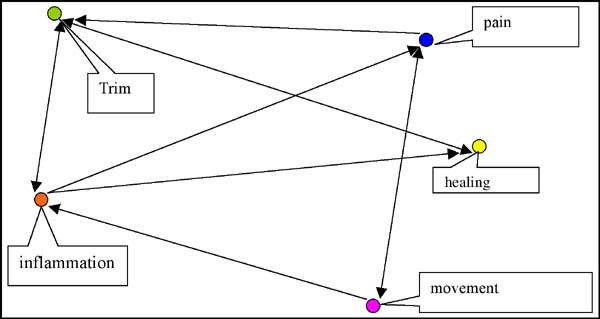
Drawing 5
So how would you describe this verbally?
We trim the horse. Inflammation may be triggered. Some inflammation
is necessary for healing. Too much inflammation causes pain. Pain reduces movement.
Movement reduces inflammation, so that reduced movement will increase inflammation.
Excess inflammation damages tissue, reverses healing, increases pain and reduces
movement again. This inflammation cycle will cause big problems for the horse
and for the trimmer.
Alternatively, we trim the horse. Moderate inflammation is triggered,
but does not cause more pain to the horse than the trim relieved. Healing is
triggered. The horse is comfortable and moves more, inflammation is kept in
check, more healing happens, more movement happens, and the horse grows normal
hoof wall and improves its general health. The owner, the horse and the trimmer
are happy.
To be more specific, if we assume (right or wrong) that one of
the parameters of a healthy foot is a coffin bone that is ground-parallel or
nearly ground-parallel, and the foot currently has a coffin bone that is elevated
at the back, or at the caudal end, the heel can be lowered all at once, or it
can be allowed to drop in stages. If the heel is lowered so quickly that it
triggers a major inflammation cycle, the horse may experience lots of pain and
tissue damage from inflammation that require a major escalation in care for
that horse, that could include a rubber-matted floor, frequent trimming to respond
to the excess growth caused by the inflammation, and hand-walking because the
horse is not choosing to move much on his own, due to pain. The consequences
of the inflammation might include bone loss and remodeling during the healing
process.
On the other hand, lowering the heel in stages might not trigger
the same degree of inflammation, minimizing pain response, may still trigger
healing, and may maintain or increasing movement of the horse, which will keep
the inflammation in check, and further improve circulation and promote more
healing. And, over time, the coffin bone might reach the same correct position
without bone loss, because the inflammation was minimal.
These scenarios don’t even begin to address variables like
the horses’ environment, their feeding regime, their breed, their herd
life, or their individual breed and personality. Whatever trim we do to the
hoof is only one of many factors that interact in the process of the horse’s
adaptation, over time, to his current environment and individual condition.
Or, as Dr. Emory put it, “Order over time requires discontinuity, unpredictability,
dynamic equilibrium, and activity ‘at the edge of chaos’ and all are
essential to the adaptive capacity of the organism.”
All of us hold “healthy function” as a goal for our
trimming of feet and care of our horses. Pathology is a concept that presumes
dysfunction as opposed to “healthy function.” However, many times,
pathology, like inflammation, is a healthy response to a situation that is dangerous
to the horse. When a horse experiences, for example, lowering of the heel that
exposes tissues to damage, the normal healthy response is inflammation that
will trigger increased heel growth, to protect that tissue. Is the excess heel
growth then pathological? Or is it a healthy response? And if it is a healthy
response, will it eventually begin to cause problems and become unhealthy for
the horse? Dr. Emory also pointed out that pitting function against dysfunction
is an oppositional, linear approach to a system that is very complex and, most
likely, not linear. Be very wary about this approach. The reality is, most horses
cope, in spite of what we identify as pathologies.
So what does this mean for us as horse hoof trimmers and horse
owners? Because the horse’s system is so committed to keeping itself as
healthy as possible within its environment, the horse can compensate for an
incredible amount of use and misuse. The horse’s complex system will compensate
for poor feed, poor housing and poor hoof care for a good long time. As we try
to correct these things, the whole system has to respond, and it will, but maybe
not in the way that we expect. Realize that a little bit of reorganizational
chaos in the system may help to facilitate the adaptations we are triggering
in the hoof and in the horse. Too much change might just push the hoof, and
the animal, right over the edge and into complete chaos and death. At the same
time, the hoof is very resilient and forgiving of mistakes. Nothing we do is
independent of the rest of the system. Pay attention, the horses that you own
and trim are depending on it.
About the author: Cynthia Niemela has been a 4-H horse project leader since 1978, CHA riding instructor in English and Western and a CHA certified Trail Guide since 1997, BS in Animal Science (emphasis dairy farm management) 1980, Strasser course graduate of 2003, and current AANHCP Practitioner in Training. She fell in love with roping horses and team penning horses in 1987 and currently most enjoys “off-trail” trail riding.
As published in Issue 23 of The Horse's Hoof Magazine
(April 2006)
©2007 by The Horse's Hoof. All rights reserved. No part of these publications may be reproduced by any means whatsoever without the written permission of the publisher and/or authors. The information contained within these articles is intended for educational purposes only, and not for diagnosing or medicinally prescribing in any way. Readers are cautioned to seek expert advice from a qualified health professional before pursuing any form of treatment on their animals. Opinions expressed herein are those of the authors and do not necessarily reflect those of the publisher.
The Horse's Hoof Website
Home - About Us - Horselover's
Corner - Articles - Barefoot
Performance - Barefoot Stories - Hoof
Gallery - Natural
Horse Care - EPSM
- The Horse's Hoof Clinics - Events
- Trimmers -
Pioneers - Friends
- Classified - Resources
- News - Links
To go shopping or subscribe to our magazine, please click here: The
Horse's Hoof Store
If you don't see a column to the left: To view the frames version of this site, please click here: TheHorsesHoof.com
The Horse's Hoof is a division of:
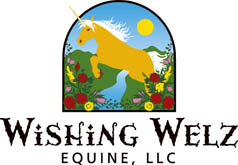
The Horse's Hoof
P.O. Box 1969
Queen Creek, AZ 85142
Phone (623) 935-1823
Message Phone: 1-623-935-1823
(Leave a message anytime.)
Email: editor @ TheHorsesHoof.com (delete spaces)